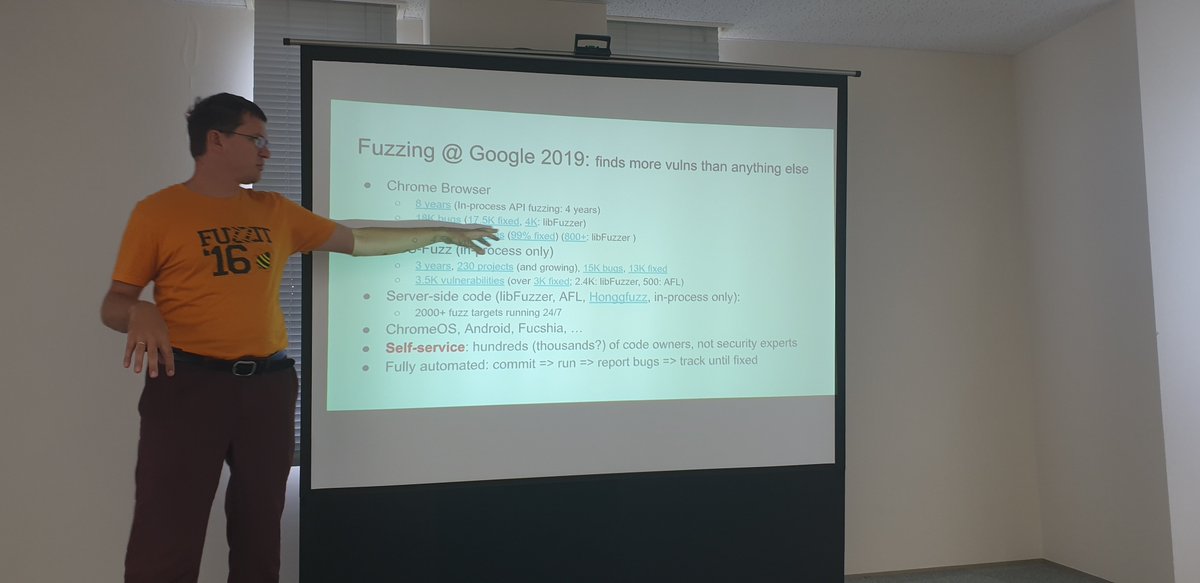
👇 Fuzzing Papers with Code 👇
In 2020, only 35 of 60 fuzzing papers published the code together with the paper. In 2021, let's do better! #reproducibility
Data from wcventure.github.io/FuzzingPaper/
Conferences: CCS, NDSS, S&P, USENIX Sec, ICSE, ESEC/FSE, ISSTA, ASE, ASIACCS, ICST.
1/5
In 2020, only 35 of 60 fuzzing papers published the code together with the paper. In 2021, let's do better! #reproducibility
Data from wcventure.github.io/FuzzingPaper/
Conferences: CCS, NDSS, S&P, USENIX Sec, ICSE, ESEC/FSE, ISSTA, ASE, ASIACCS, ICST.
1/5
Alphabetically,
* github.com/aflnet/aflnet
* github.com/aflplusplus/AF…
* github.com/andreafioraldi…
* github.com/assist-project…
* github.com/duytai/sfuzz
* github.com/fau-inf2/StarS…
* github.com/hexhive/USBFuzz
* github.com/hexhive/FuzzGen
* github.com/hexhive/retrow…
* github.com/hub-se/MoFuzz
2/5
* github.com/aflnet/aflnet
* github.com/aflplusplus/AF…
* github.com/andreafioraldi…
* github.com/assist-project…
* github.com/duytai/sfuzz
* github.com/fau-inf2/StarS…
* github.com/hexhive/USBFuzz
* github.com/hexhive/FuzzGen
* github.com/hexhive/retrow…
* github.com/hub-se/MoFuzz
2/5
* github.com/iromise/fans
* github.com/michael-emmi/c…
* github.com/moonmight-stei…
* github.com/piano-man/DPIF…
* github.com/practical-form…
* github.com/rub-syssec/cup…
* github.com/rub-syssec/hyp…
* github.com/rub-syssec/ijon
* github.com/seemoo-lab/fra…
* github.com/sslab-gatech/D…
3/5
* github.com/michael-emmi/c…
* github.com/moonmight-stei…
* github.com/piano-man/DPIF…
* github.com/practical-form…
* github.com/rub-syssec/cup…
* github.com/rub-syssec/hyp…
* github.com/rub-syssec/ijon
* github.com/seemoo-lab/fra…
* github.com/sslab-gatech/D…
3/5
* github.com/sslab-gatech/f…
* github.com/softsec-kaist/…
* github.com/testsmt/yinyang
* github.com/rortoisefuzz/T…
* github.com/tudinfse/SpecF…
* github.com/qianzhanghk/Bi…
* github.com/uds-se/lFuzzer
* github.com/vusec/parmesan
* github.com/wcventure/MemL…
* github.com/wsp-lab/Montage
4/5
* github.com/softsec-kaist/…
* github.com/testsmt/yinyang
* github.com/rortoisefuzz/T…
* github.com/tudinfse/SpecF…
* github.com/qianzhanghk/Bi…
* github.com/uds-se/lFuzzer
* github.com/vusec/parmesan
* github.com/wcventure/MemL…
* github.com/wsp-lab/Montage
4/5
* github.com/yannicnoller/h…
* github.com/yanxxd/PathAFL
* github.com/yuqichen94/Act…
* github.com/zongpy/FuzzGua…
5/5
* github.com/yanxxd/PathAFL
* github.com/yuqichen94/Act…
* github.com/zongpy/FuzzGua…
5/5
• • •
Missing some Tweet in this thread? You can try to
force a refresh






